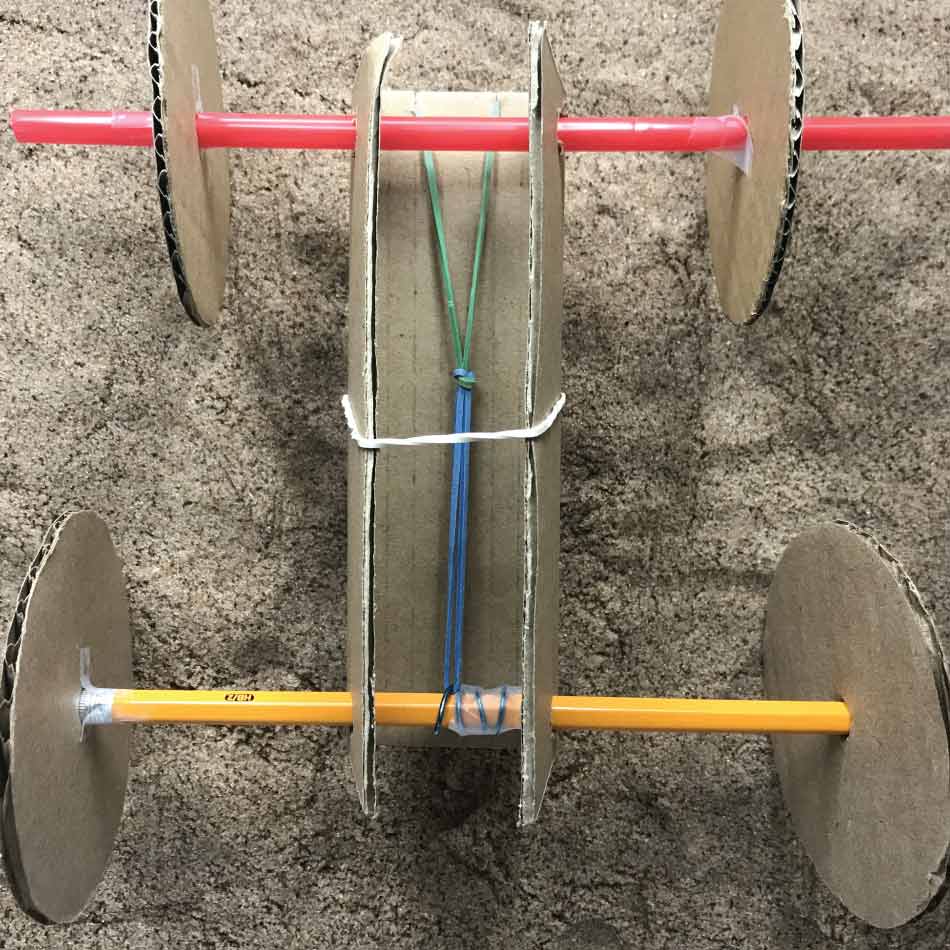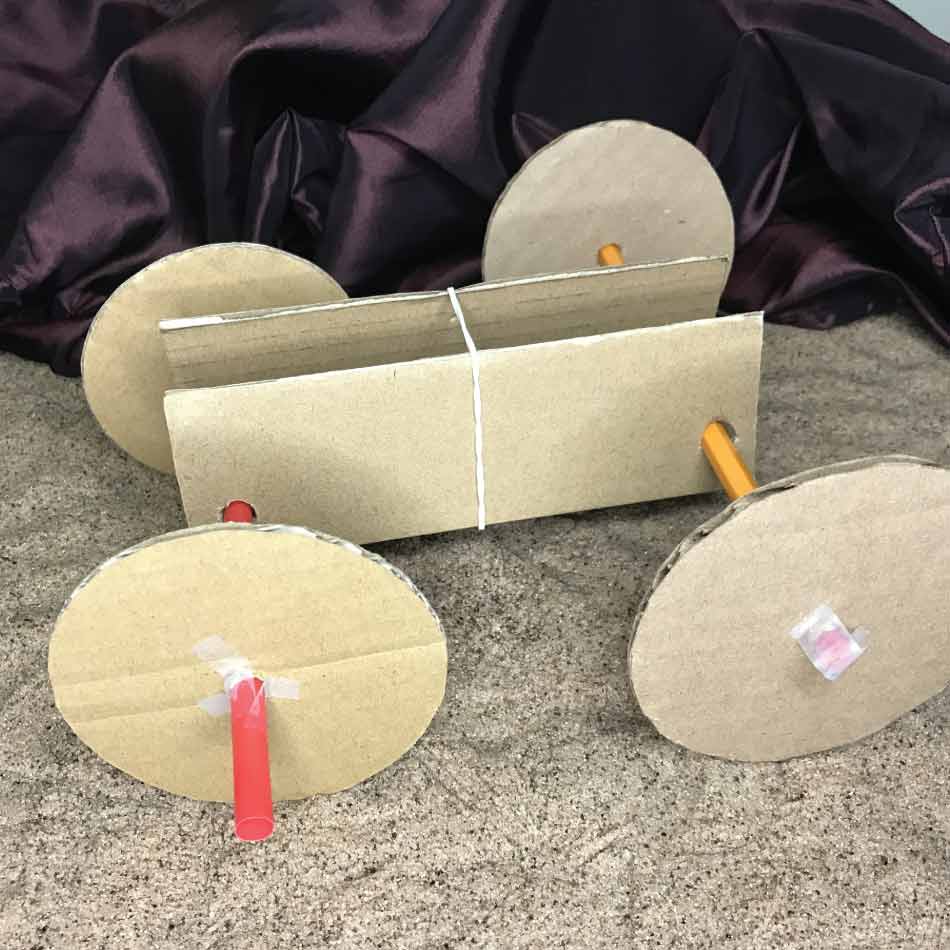Make a Cardboard Rover
Learn about tension, friction and energy transfer.
- All
- Things to Make
- Experiments
- Space
What you’ll need:
- Corrugated cardboard
- A ruler
- Scissors
- 1 sharpened pencil and a straw (or another pencil)
- Tape
- A paperclip
- 2-3 rubber bands
- Plastic bins (optional)
- Cornstarch, sand and pebbles (optional)

Activity setup:
- Cut out the cardboard pieces
Cut the corrugated cardboard into five separate pieces: one square measuring 15 x 15 cm (the rover body) and four circles measuring 10 cm in diameter (the wheels). - Make the rover body
Fold the 15 x 15 cm cardboard square into thirds along (not across) the corrugation (the tubes inside the cardboard). The two ends should be folded upwards. - Create the axle holes
Designate a front side of the body. On one of the ends that’s folded upwards, use the sharpened pencil to poke a front axle hole located 1 cm from the front edge and 1.5 cm from the bottom of the cardboard section. Make the hole big enough to allow the pencil (the axle) to spin freely.
Repeat this step on the opposite front side of the rover, making sure the second hole is directly across from the first hole. Then, repeat this step for the back axle holes. - Attach the wheels
Push the straw through the front axle holes. If you do not have a straw, you can use a pencil instead. Insert a pencil through the back axle holes. Use tape to secure the four 10-cm cardboard circles (the wheels) to the ends of the axles. - Create the axle hook
Straighten out a paperclip (the axle hook). Wind it around the centre of the back axle until 0.5 cm is sticking up from the axle, then tape it in place. - Attach the rubber bands
Tie two or three rubber bands together. At the middle of the front edge of the rover, cut two slits that are about 0.5 cm deep and 2 cm apart. Slide one end of the rubber band link into the slits and attach the opposite end onto the axle hook. - Make the rover move
Rotate the back axle repeatedly to wrap the rubber band around it until it is tight. Holding the axle, place the rover on the ground. Then, release the axle and watch the rover go!

Try This!
- If your rover doesn’t go very far, try increasing the number of turns of the rubber band around the axle.
- If the sides of the rover body spread open and cause the axle hole to rub against the axle, wrap a rubber band around the body to hold the sides upright.
- Bigger wheels with a larger outer edge will cause the rover to move farther with each rotation. Try making a rover with larger wheels, thicker wheels, different wheel shapes (e.g., hexagon or square) or even an extra set of wheels.
- Test how the rover travels on different terrains by filling several bins with various materials, such as cornstarch, sand or pebbles. Record and compare your observations.

What's happening?
As the rubber band winds around the axle, its potential energy (the energy stored in the band) increases. When the band unwinds and causes the axle and wheels to turn, this potential energy transforms into kinetic energy (the energy causing motion) and moves the rover forward.
If the rubber band on your rover is delivering too much power to the wheels at once, the rover might go into a spinout. This is caused by the wheels spinning too quickly to grip the surface below. There are two things you can try to reduce the tension in your rubber band:
- Add more rubber bands to the rubber band link
- Cut the rubber band to create a single elastic strand instead of a loop
Another important factor to consider is friction, which is the force of resistance between two objects in contact with each other. For the rover’s wheels to spin effectively, the friction that occurs between the axle holes and the axle should be minimal. The friction between the wheels and the surface beneath the rover, known as traction, is also key. Without enough traction, the wheels won’t be able to grip the surface. Instead, they will spinout just like a car stuck on ice or snow.
There are a few things you can try to adjust the level of friction:
- Make the wheels thicker
- Add more wheels
- Add more weight on top of the back axle
- Place the rover on a more textured surface to create more friction

About Perseverance, the Mars rover
Rovers are similar to snowmobiles and dune buggies. They have powerful engines and good traction, are very stable and do not need a road to drive on.
The wheels of Perseverance, a NASA Mars rover, are made from flight-grade aluminum. These wheels are narrower and slightly larger in diameter than NASA’s previous Mars rover, called Curiosity. They have titanium spokes and 48 gently curved treads (also called grousers). These treads help the rover drive on sand and withstand pressure from sharp rocks.
Perseverance will face two major challenges on Mars. The first is Martian dust storms, which can last for weeks or even months. This dust is very fine—like talcum powder or cornstarch—and slightly electrostatic, causing it to stick to everything. The second challenge is the planet’s harsh and uneven terrain, which may damage the rover’s wheels.
The solar panels and gears on Perseverance will be vulnerable to Martian dust, while its wheels may be damaged by the Red Planet’s terrain. Mechanical issues or wheel failures have the potential to end Perseverance’s mission early.